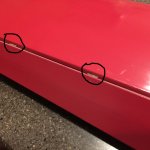Hey everybody!
This is my first post here. I inherited a Telemaster 40 in excellent condition (except for some minor issues) from my late step-father and it looks to be about 30 years old. I have a few questions for this group and I'm seeking some advice.
First, we (my seventeen year old son and I) are both neophytes to this hobby, so we decided to get some flying experience before ever thinking about flying the Telemaster. We purchased the "FT Simple Cub Get Started Package" kit with the DX6e radio to build and learn to fly RC planes. After looking at RTF and ARF options we decided the Flight Test kit would give us more flexibility going forward. We are currently having a blast building that plane now.
The Telemaster was an IC plane back in the day and I would like to convert it to EP if possible. As I will have a DX6e radio, I would like to get a compatible Rx for it. I might also want the option of a SAFE enabled Rx from Spektrum, so I have less of a chance of crashing it . Any recommendations on a compatible Rx to my DX6e for SAFE tech? As it stands now, there are no Ailerons and would need to be modified to be a 4 channel plane or I could just fly it as a 3 channel and leave it as it is.
. Any recommendations on a compatible Rx to my DX6e for SAFE tech? As it stands now, there are no Ailerons and would need to be modified to be a 4 channel plane or I could just fly it as a 3 channel and leave it as it is.
Also, as the Telemaster is an older plane, would you even consider flying this old bird again? It does have some issues with the elevators connection (the fabric or material has dry rotted off) to the horizontal stabilizer. The two sides of the elevator are still solidly connected to each other by a metal rod. Any suggestions on reconnecting them to the horizontal stabilizer? I'm not sure what the skin is, it could be tissue or some type of plastic if that helps at all.
This looks like a really nice forum and I look forward to my time here
Peace -Aaron
This is my first post here. I inherited a Telemaster 40 in excellent condition (except for some minor issues) from my late step-father and it looks to be about 30 years old. I have a few questions for this group and I'm seeking some advice.
First, we (my seventeen year old son and I) are both neophytes to this hobby, so we decided to get some flying experience before ever thinking about flying the Telemaster. We purchased the "FT Simple Cub Get Started Package" kit with the DX6e radio to build and learn to fly RC planes. After looking at RTF and ARF options we decided the Flight Test kit would give us more flexibility going forward. We are currently having a blast building that plane now.
The Telemaster was an IC plane back in the day and I would like to convert it to EP if possible. As I will have a DX6e radio, I would like to get a compatible Rx for it. I might also want the option of a SAFE enabled Rx from Spektrum, so I have less of a chance of crashing it
Also, as the Telemaster is an older plane, would you even consider flying this old bird again? It does have some issues with the elevators connection (the fabric or material has dry rotted off) to the horizontal stabilizer. The two sides of the elevator are still solidly connected to each other by a metal rod. Any suggestions on reconnecting them to the horizontal stabilizer? I'm not sure what the skin is, it could be tissue or some type of plastic if that helps at all.
This looks like a really nice forum and I look forward to my time here
Peace -Aaron
Attachments
Last edited:


